Before we introduce this China train tour with Silk Road, I’d like to introduce the Silk Road to you first. The Silk Road is neither an actual road nor a single route. The term instead refers to a network of routes used by traders for more than 1,500 years. German geographer and traveler Ferdinand von Richthofen first used the term Silk Road in 1877 C.E. to describe the well-traveled pathway of goods between Europe and East Asia. The term also serves as a metaphor for the exchange of goods and ideas between diverse cultures. Therefore, our 11 days train tour starts from Xi’an, the starting point of the Silk Road. During our journey, you can not only visit Xi’an and Zhangye but enjoy the Dunhuang to Turpan Train Tour on the China fast train. What are you waiting for? All you have to do is just join us by choosing this wonderful China train tour with Silk Road.

Today you will arrive in Xi’an, and your local tour guide will pick you up at the airport. Then you will be transferred to the hotel for a good rest.
Welcome to the ancient city of Xi’an, the capital of Shaanxi province. Xi’an, or Chang’an as it was called for many centuries, has been a built-up urban area for over 3,000 years and served as the capital of feudal China for 1,100 years. In the seventh century, Xi’an was the world’s largest city with a population of more than 1 million. Thanks to the opening of the ancient Silk Road, its influence gradually has extended far and wide. Through the Silk Road, the Han and Tang empires imported and embraced the salutary elements of other civilizations like Buddhism, western painting, and music, incorporating them into the Chinese cultural system. This created Xi’an’s rich and diverse culture.
When it comes to Xi’an, we have to talk about the Xi’an cooked wheaten food, the representation of northern Chinese food. A representative local snack is Rougamo, which looks like a Chinese hamburger. However, it is not a kind of fast food. In an authentic Rougamo, the minced pork inside is stewed for hours in a soup containing more than 20 kinds of spices and seasonings. The outside flatbread is made of wheat flour, and it is baked in a clay oven. Has this mouthwatering local food whetted your appetite? If your answer is yes, just go and eat them!
This morning, we will drive northeast for about an hour to the Terra Cotta Warriors and Horses Museum, 40 kilometers away from the center of Xi’an. These terra cotta warriors and horses are buried in Emperor Qin Shihuang’s (259-210) subordinate tomb. Emperor Qin Shihuang, the first emperor of the Qin Dynasty (221-207), spent 39 years building his mausoleum. These life-size terra cotta warriors were unearthed in 1974 and besides the terra cotta army, bronze swords were also unearthed. One of the bronze swords surprised people. Although the sword has been buried underground for more than 2,000 years, its surface is as bright as a new one and the blade is very sharp. It is analyzed that the surface of the sword has a protective layer of chromium oxide, thus it has not got rusty. It is surprising that ancient Chinese people in 2,000 years ago has already got such advanced skills. Besides, the bronze sword was bent under a 150kg clay figure when it was excavated. It had bent down over 45 degrees but when the clay figure had been removed, the sword bounced back and became as straight as it had been. What a miracle!
After lunch, you will be driven to the Big Wild Goose Pagoda, 50 kilometers west of the Terra Cotta Warriors and Horses Museum. It takes about one and a half hours to get there. The pagoda was built for Xuan Zang, an influential monk of the Tang Dynasty (618-907), to preserve a large number of Buddhist scriptures and Buddhist relics brought back from India. There is a legend about the origin of the Big Wild Goose Pagoda. When Xuan Zang took his journey to the west to obtain Buddhist scriptures, he was once trapped in a desert. There was no water and no food. However, a goose helped him find some water so he could survive. Xuan Zang believed that the goose was sent by Bodhisattva. After Xuan Zang returned to Xi’an, he wanted to show his gratitude to Bodhisattva. Therefore, he built this pagoda.
The last attraction you will visit today is the Great Mosque. It covers a total area of 13,000 square meters and can accommodate 1,000 people for worship. Now the mosque is not only a place for Muslims to worship but also a tourist attraction for people all over the world to visit. And even French President Emmanuel Macron visited the Great Mosque in 2018. If you want to experience both the Islamic and Chinese cultures, why not go there?
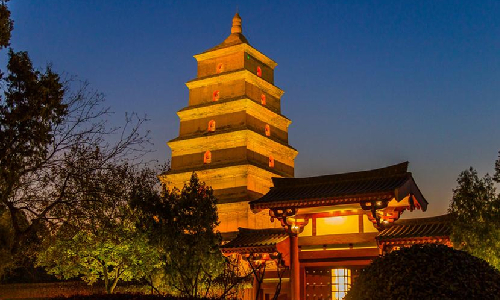
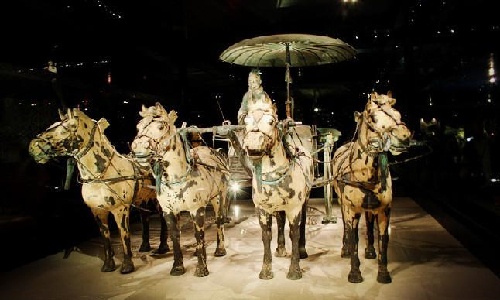
 Zhangye
Zhangye After breakfast, you will be transferred to the railway station and head to Zhangye by taking the estimated train D2687 10:16/18:00. The China bullet train you take can reach a top speed of 350 km/h (217 mph). Your tour guide will be waiting for you at the arrival lobby and then transfer you to the hotel.
Zhangye is located in the northwest of Gansu Province. It is very dry there so you had better take body lotion and sunscreen to take good care of your skin. It serves as an outpost connecting central Asia to ancient China via the Silk Road. Zhangye also enjoys diverse natural views varying from snow mountains to grasslands. Attracted by these magnificent views, Marco Polo, a famous Italian adventurer, is said to have spent a year here around 1274. He also provided a detailed description of Zhangye (by its historical name, Campichu) in The Travels of Marco Polo. In addition, with abundant rivers, sunshine, and fertile land, Zhangye is the largest corn seed production area in China and serves as an important production base of grain, vegetables, melon, and fruit, etc. As for dinner, you can give the local food a try, such as fish-shaped noodles, special yogurt made from fermented mare’s milk, and other northwestern dishes. Just go and give it a try!
This morning, we will visit the Big Buddha Temple. Why it is named the Big Buddha Temple? Because there is a gigantic reclining Buddha, which is 34.5 meters long and 7.5 meters wide between its two shoulders, with feet of 4 meters and ears of 2 meters. It is the largest Buddha carved of wood in Asia. If you can’t imagine how huge this Buddha is, I’ll describe it more vividly. A man can lie on just one finger of the Buddha. Besides, an ear of the Buddha can accommodate eight people sitting side by side. As the Buddha’s body is made of wood, there is a large room inside it. In 1966, stone tablets, copper Buddha, bronze mirror, copper pot, sutras were found in the belly of the Buddha, as well as a copper plate, which recorded an earthquake that happened in the Chenghua Period during the Ming Dynasty (1465-1487). While appreciating the Buddha, careful visitors may find its eyes close slightly as if the smiling Buddha was sleeping. It’s worth mentioning that many tourists feel the Buddha’s calm expression move them a lot.
After lunch, you will be driven to the Zhangye Danxia National Geological Park, over 50 kilometers west of the Big Buddha Temple. It takes about one and a half hours to get there. The Zhangye Danxia National Geological Park covers an area of 536 square kilometers, which is equivalent to the area of Andorra. The red sandstones have shaped into isolated mountains and steep rocks after years of weathering and water erosion, together with the influences brought by the special geological structure, climate change, and wind power. The most distinctive area here is the Colorful Hills, featuring bright and contrasting colors. Besides, the park provides four viewing platforms for visitors to admire the scenes and take pictures. Furthermore, it earned the reputation of China’s Rainbow Mountain and also one of the Top 10 Geographical Wonders of the World selected by National Geographic.

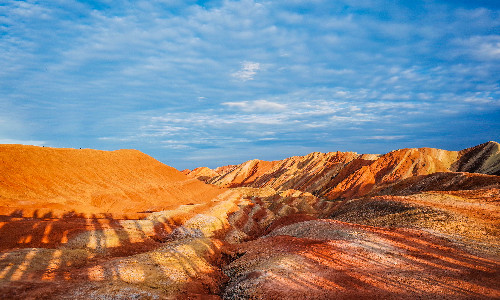
 Dunhuang
Dunhuang After breakfast, you will be transferred to the railway station and head to Dunhuang by taking the estimated train D4011 10:40/14:39. Though Zhangye and Dunhuang are more than 600 kilometers apart, you can travel between them in only four hours by China’s fast train. Upon arrival, your tour guide will pick you up at the arrival lobby and transfer you to the hotel.
Dunhuang covers an area of 31,200 square kilometers, of which the oasis accounts for only 4.5% of the total area. The spectacular desert view attracts countless tourists every year. In addition to the natural scenery, the culture of Dunhuang is also fascinating. Dunhuang gives birth to a new term Tunhuangology. The word is coined by a Japanese scholar. Tunhuangology refers to a subject that involves the studies of literature, historic relics, and the art of grottoes in Dunhuang. If you are interested in this increasingly popular subject, Dunhuang is the best place to explore.
After breakfast, we will drive eastward for about 20 minutes to the Mogao Grottoes, 10 kilometers away from Dunhuang downtown. Mogao Grottoes is one of the largest grottoes in China. It is commonly known as the Thousand Buddhas Caves. The word “Thousand” does not mean that there are one thousand caves but serves as a metaphor to say that there are numerous caves. You may wonder why there are so many caves in Dunhuang. On the one hand, people here have always believed in Buddhism since ancient times. Therefore, no matter the officials, the rich or the common people even the poor, they would like to pour money into digging caves, building Buddha statues, and painting murals to offer sacrifices to the Buddha. On the other hand, Dunhuang acts as a vital place on the Silk Road. At that time, many trade caravan envoys and monks traveling on the Silk Road need to pass by Dunhuang. They invested money in building grottoes of the Buddha to pray that they could pass through the desert safely. These are reasons that there are various grottoes and Buddhas. Until now, you can still visit several caves with different types of Buddha statues and murals.
After lunch, we will go to the Echoing-sand Dune and Crescent Lake. First, we will talk about the Echoing-sand Dune. It is piled up by colorful sand grains, which touch soft. If you visit Dunhuang in June, you may have an excellent opportunity to enjoy the Sand Skiing Festival. On the first day of June, hundreds of people who love sand skiing will come to Dunhuang and slid down from the dune, sending out a thunderous sound that could be heard in the downtown five kilometers away. Why the sand could roar while people are sliding down? Scientifically, the noise is made by static electricity. Pushed down by human or wind power, the sand grains, containing quartz crystals, rub with each other and then produce static electricity; electrostatic discharge can make a sound so all the sounds together are as loud as thunders.
Next, we will talk about Crescent Lake. Can you guess the shape of the lake? Yes, it is like a half-moon. It covers an area of 8,800 square meters and its average water depth is 4.2 meters. The lake is surrounded by the Echoing-sand Dune. However, it has never been covered by sand.
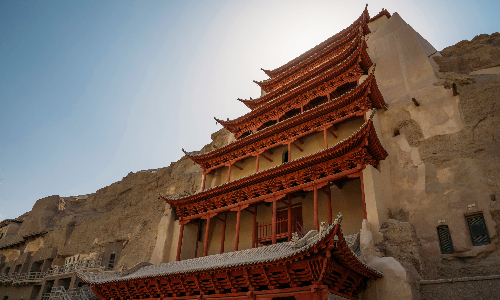
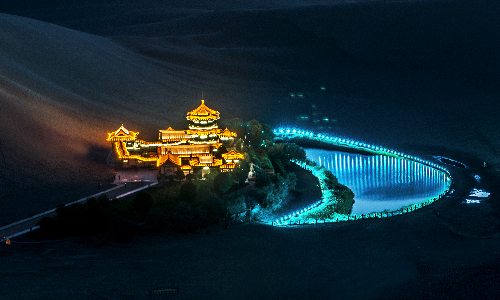
 Turpan
Turpan This morning, we will go to the Dunhuang Museum (closed each Monday). It is founded in 1979 and it covers a total area of 16,000 square meters. It mainly presents more than 10,000 historic items of Dunhuang. People can learn a lot about Dunhuang and Silk Road in this informative museum. The museum is well laid out in chronological order. There is one Preface Hall and five Exhibition Halls. The Preface Hall mainly introduces the prehistoric civilization of Dunhuang and the five Exhibition Halls show the unearthed cultural relics in Dunhuang of different dynasties respectively. What’s more, there are replications of the Mogao Cave and some exquisite murals. As taking photos is not allowed in Dunhuang Mogao Caves, tourists can take some photos here instead. Besides, there are rooms for visitors to watch films and have a rest. If you are interested in the culture of Dunhuang, you should not miss the Dunhuang Museum.
After lunch, you will be driven to Liuyuan railway station. Then you will head to Turpan by taking the estimated train D55 16:35/19:56. After arriving in Turpan, your local tour guide will pick you up at the train station. Then you will be transferred to the hotel for a good rest.
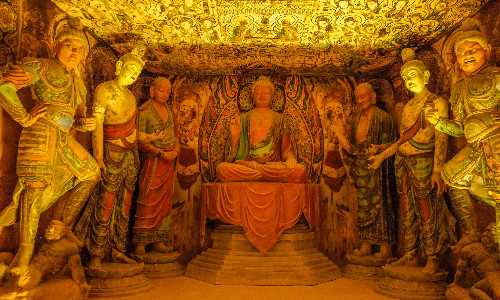

This morning, we will go to the Sugong Pagoda. It is the biggest pagoda in Turpan and has a history of more than 200 years. Sugong Pagoda is shaped like a cone which is 37 meters high and its base is 10 meters in diameter. The name Sugong – Su refers to a Chinese last name and Gong is an old term of respect for a male elder – is to commemorate a man called Su Laiman who finished building this pagoda. In the Qing dynasty (1664-1912), the sheriff of Turpan was a patriot and he suppressed the division and rebellion in many parts of Turpan. Therefore, he was awarded and commended by the emperor of Qing many times. The Sheriff planned to build a pagoda to repay the favor of the Qing dynasty, as the emperor of the Qing dynasty appreciated his abilities and gave him an important position. What’s more, he also wanted to express his piety to Allah, thus you can see the pagoda is like Islamic architecture. Unfortunately, the sheriff died before the pagoda was completed. Therefore, his son Su Laiman, who came into his father’s title and became the second sheriff of Turpan, finished his father’s work. Thus, the pagoda is named after Su Laiman, who also won many victories like his father. There is a large mosque that is still in use next to Sugong Pagoda. The mosque’s hall of worship can hold more than a thousand people. It is a good place to experience Islamic culture.
After visiting the Sugong Pagoda, you will visit the Karez Well. Along with the Great Wall and the Grand Canal, they are known as the three major projects in ancient China. As Turpan is one of the driest regions in China, water is precious and important for people here. Therefore, these wise people came up with an idea to exploit and utilize underwater, and then the Karez Well was born. Water in the Karez Well has long been one of the main water sources for people’s farming and stock raising in Turpan. Do you want to know what is the Karez Well like? You will explore it in person here in Turpan.
After lunch, we will visit the Jiaohe Ruins. Jiaohe was once a city built by Cheshi people, early inhabitants of Turpan. The city was prosperous at first. From the 9th to the 14th century, however, the city gradually declined due to successive wars. At the end of the Yuan Dynasty (1271-1368), the Jiaohe City was so badly damaged by wars. Thus, here you can only see some well-preserved ruins. The north and south of the Jiaohe Ruins are more than 1600 meters long, and the widest part is about 300 meters from east to west. When it comes to the layout of the Jiaohe Ruins, we can see it is divided into temples area, dwelling area, and government area. Walking in the Jiaohe Ruins, we can still feel a scene of prosperity at that time.

 Kashgar
Kashgar This morning, we will go to the Bezikrik Thousand Buddha Caves. It has a history of over 1500 years. Among the existing caves in Turpan, it has the most caves and the most abundant murals. Most of the mural paints here are extracted from rocks or plants. In addition, Turpan has a dry climate, so these murals are still bright in color for thousands of years. The content of the murals is mostly stories in Buddhist scripture or scenes of the Buddha preaching. All the murals and Buddha sculptures here have high ornamental value.
Then we will see the famous Flaming Mountains. Located in the hottest area in China, these mountains seem to be burning and thus they got the name Flaming Mountains. It is said that the temperature on the top of these mountains could reach 80 degrees Celsius. Surprisingly, there is a small oasis behind the Flaming Mountains, where grapes are grown. There is also the only family near Flaming Mountain. The people in this family manage the vineyards here. And after the grapes get matured, they will be sun-dried into raisins. The raisins here are particularly sweet because of the long sunshine hours and the large temperature difference between day and night. Are you interested in the Flaming Mountains? If your answer is “yes”, come and join us to visit it.
After lunch, we will go to the Gaochang Ruins, which is not far from the Flaming Mountains. Gaochang City was once the biggest historic and cultural city in Turpan. In its heyday, it was the Buddhist center and political center of Turpan. The famous Chinese monk Master Xuanzang used to expound the Buddhist scriptures here. The Gaochang Ruins consists of three parts: outer city, inner city, and palace area. Surprisingly, although the walls were made of loess, the cheapest and handiest building material, they were extremely solid to resist the attacks of enemies at that time.
After visiting, you will be transferred to the railway station and head to Kashgar by taking the estimated train K6737 21:53/11:12 +1. It takes a lot of time but please do not worry. We bought the soft sleeper for you to make your tour enjoyable. Compared with the hard sleeper, the soft sleeper is more spacious with only four berths inside one compartment, two upper berths, and two lower berths; the berth is wider and larger. In addition, the door of the compartment separates it from the aisle and provides a quiet room for you.


Today you will arrive in Kashgar, and your local tour guide will pick you up at the train station. And then you will be transferred to the hotel for a good rest.
After lunch, we will go to explore the mysterious Abakh Hoja Tomb. It is an ancient Islamic building and covers a total area of 20,000 square meters. In China, the tomb is better known as the Tomb of Xiang Fei (Fragrant concubine in Chinese). Xiang Fei is the only Uyghur concubine among the 41 concubines of Emperor Qianlong in the Qing Dynasty (1644-1911). Legend has it that she could exude an enchanting fragrance without using any perfume. Emperor Qianlong doted on Xiang Fei. At that time, in the strictly regulated royal palace, ethnic clothes are not allowed to be worn. But Emperor Qianlong allowed Xiang Fei to wear the Uyghur costume in the royal palace. Before she died, Xiang Fei expressed her desire to be buried in her hometown of Turpan. Then the emperor sent back her funeral things to Turpan after she died and built the Abakh Hoja Tomb.
The next attraction we will visit is the Id Kah Mosque. “Id Kah” means “a festival and joyous place”. The mosque occupies 16,800 square meters and consists of the courtyard, the Hall of Prayer, the gate tower as well as some other attached structures. If you visit the mosque during the Corban Festival (December 10th on the Islamic calendar), one of the most important festivals for Muslims, you may have a chance to see the grand celebration activities here.
And then you will go back to the hotel and have a good rest.


 Urumqi Departure
Urumqi Departure Today your 11-day China train tour comes to an end. Your tour guide will accompany you to the airport and say goodbye to you. Then you will head to Urumqi by taking the estimated flight GS7562 10:40/12:30. At last, you will board your flight back home.
Author: Liya Zhang
Proofreader: Betsy He
| City | Five Star hotel list | Four Star hotel list |
|---|---|---|
| Xi'an | Tianyu Gloria Grand Hotel Xi'an | Sunworld Dynasty Hotel |
| Zhangye | Zhangye Hotel | Zhangye Dinghe International Hotel |
| Dunhuang | Wan Sheng International Hotel | Grand Sun Hotel Dunhuang |
| Turpan | Jinjiang Metropolo Hotel - Turpan Administration Center | Mercure Hotel Turpan Downtown |
| Kashgar | Yue Xing Jin Jiang International Hotel | Tianyuan International Hotel |
 |
![]() About your child or infant, please contact us for a discounted price.
About your child or infant, please contact us for a discounted price.



We started with a few days in Beijing & ended in Shanghai, from where we visited the Forbidden City and Great Wall. In between we visited Terra Cotta Warriors Museum, Panda Base, Shanghai Disneyland.

We had a wonderful holiday in China which will remain long in the memory. China is a breathtakingly beautiful country full of splendid temples and palaces, mountains and rivers, peaceful rural scenes and bustling shopping streets.
 QUICK ENQUIRY
QUICK ENQUIRY